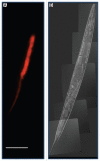An insect pathogenic symbiosis between a Caenorhabditis and Serratia
- PMID: 21389770
- PMCID: PMC3100764
- DOI: 10.4161/viru.2.2.15337
An insect pathogenic symbiosis between a Caenorhabditis and Serratia
Abstract
We described an association between a strain of the nematode Caenorhabditis briggsae, i.e. KT0001, and the bacteria Serratia sp. SCBI (South African Caenorhabditis briggsae isolate), which was able to kill the insect Galleria. Here we show that the Serratia sp. SCBI lines the gut of the nematode, similar to the Heterorhabditis-Photorhabdus complex, indicating that the association is possibly internal. We also expand on the relevance of this tripartite, i.e. insect-nematode-bacteria, interaction in the broader evolutionary context and Caenorhabditis natural history.
Figures


Comment on
-
An entomopathogenic Caenorhabditis briggsae.J Exp Biol. 2010 Sep 15;213(Pt 18):3223-9. doi: 10.1242/jeb.043109. J Exp Biol. 2010. PMID: 20802125
References
-
- Adams BJ, Fodor A, Koppenhöfer HS, Stackebrandt E, Stock SP, Klein MG. Biodiversity and systematics of nematode-bacterium entomopathogens. Biol Control. 2006;37:32–49.
-
- Stock SP. Insect-parasitic nematodes: From lab curiosities to model organisms. J Invert Pathol. 2005;89:57–66. - PubMed
-
- Chapuis E, Emelianoff V, Paulmier V, Le Brun N, Pagès S, Sicard M, et al. Manifold aspects of specificity in a nematode bacterium mutualism. J Evol Biol. 2009;22:2104–2117. - PubMed
-
- Abebe E, Jumba M, Bonner K, Gray V, Morris K, Thomas WK. An entomopathogenic Caenorhabditis briggsae. J Exp Biol. 2010;213:3223–3229. - PubMed
-
- Roughgarden J. The theory of coevolution. In: Futuyama DJ, Slatkin M, editors. Coevolution. Sunderland, MA: Sinauer Associates Inc. Publishers; 1983. pp. 33–64.
Publication types
MeSH terms
LinkOut - more resources
Full Text Sources
